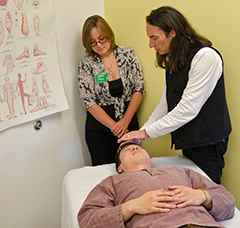 When it comes to confidence building, you can’t beat experience.
When it comes to confidence building, you can’t beat experience.
That’s the aim of a new type of Clinical Observation rotation created for students preparing to transition into their clinical internship year in the School of Classical Chinese Medicine (CCM). In the standard Observation rotation, five students develop clinical acumen by watching their seasoned faculty supervisors diagnose and treat patients. The newly implemented Hands-On Training (HOT) technique combines observation, step-by-step explanations of techniques, clinical reasoning by faculty members, and finally, direct student involvement in all aspects of the patient visit. To ensure adequate time for each student to receive individual attention from the faculty supervisor, the HOT rotations are limited to three students.
The result has been powerful in building clinical skill and confidence, said Dr. Laurie Regan, dean of CCM. “Students and faculty alike find the HOT approach to be a highly successful system,” said Regan. “Students feel more prepared to take on the responsibilities assigned to the intern role.” Before, she said, students heading into their final internship rotations had lots of classroom work, extensive observation and interaction with faculty, but little time actually treating patients.
First used in business and popularized by author Gary Sisson, CCM’s version of Hands-On Training was developed by NCNM Board Member Dr. Steve Marsden, who holds licenses as a DVM, ND and LAc. Marsden adapted the technique to train new practitioners in his veterinary and medical clinics. He found that using the systematic HOT approach led to a much more consistent level of competence and confidence in his trainees, Regan said.
“So far, that’s been CCM’s experience, too,” said Regan, adding that one reason it works is that it expands the types of learning styles addressed in the clinical education environment. “Normal observation involves auditory and visual learning. This approach adds a kinesthetic component.”
HOT also harkens back to the traditional Chinese master/student approach, though for modern practical purposes it occurs in a vastly compressed timeframe of months instead of years.
Assistant Professor Brandt Stickley, LAc, led a group through the program. Stickley said HOT “takes that traditional approach and adds on a more explicit articulation of the teaching process. It fulfills the (traditional) model, but makes it accessible.” The hands-on technique further connects to tradition by following the philosophy that mastery is about removing impediments to learning. “Complete immersion in the work with supervision accomplishes that,” he said.
Stickley, who added that he had an exceptional trio of students, saw the approach as an opportunity to improve his teaching. “I was challenged to articulate the decision-making process at every stage of the game.” Acupuncture involves so much subtlety, he said—the angle and depth of a needle, the right point of entry, recognizing the clues the patient is giving—that real, guided clinical experience is critical.
Students in Stickley’s HOT group responded with amazing focus and synergy. He said that they palpated patients for illness cues, took pulses, observed the terrain of the body, temperature and tissue state, and developed a course of treatment. They then applied the needles and gauged the result, which was almost universally positive. “Some of the patients had very serious problems,” said Stickley, “I was extremely pleased with the results.”
One of Stickley’s fourth-year students, Claire Matturro, said the HOT experience was an essential component for her success as an intern at Portland’s Outside In and other busy public clinics. “It was hands down the most valuable experience I had at the school,” she said, “making the transition to internships, it was so critical to be confident in what I was doing.” Matturro added that the first internship experience treating real patients with real needs can be nerve-racking. However, she said, the HOT experience made for a “super-easy transition. I was just confident I could do it.”
One thing that really helped, she thought, was Stickley’s trust. The group also had great chemistry throughout the 12-week rotation, so much so, that they were often on the same page during treatments. The treatment results demonstrated how well the process worked. More than anything, she said, that’s what really stood out as perhaps the most inspiring and confidence-building. The students were able to provide help for some chronic ailments, including one patient who saw relief for the first time in years for his persistent migraine headaches.
Although HOT costs more than previous rotations due to its small student-to-faculty ratio, Regan and the CCM faculty decided not to tinker with increasing the number of students per shift. She sees HOT not only continuing, but contributing to a planned proposal for the college’s first professional doctorate program.
Virtually all clinical faculty participated in the program this past spring. Regan said the college is excited to see another round this winter. “It’s training that really raises confidence,” she said.
The results: that ever-valuable “I can do it.”